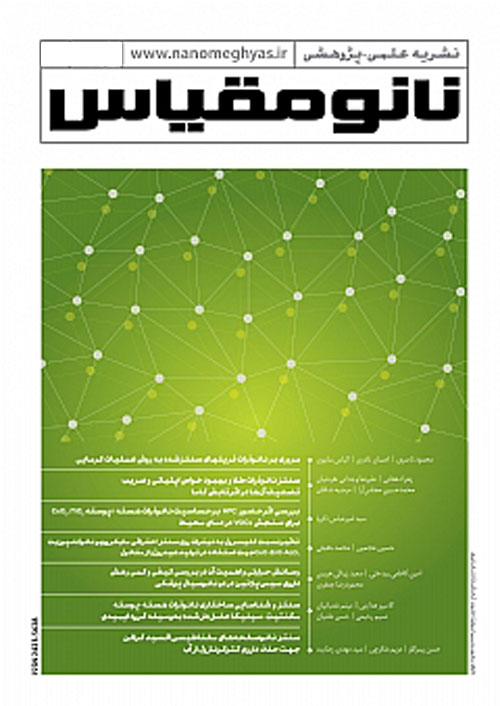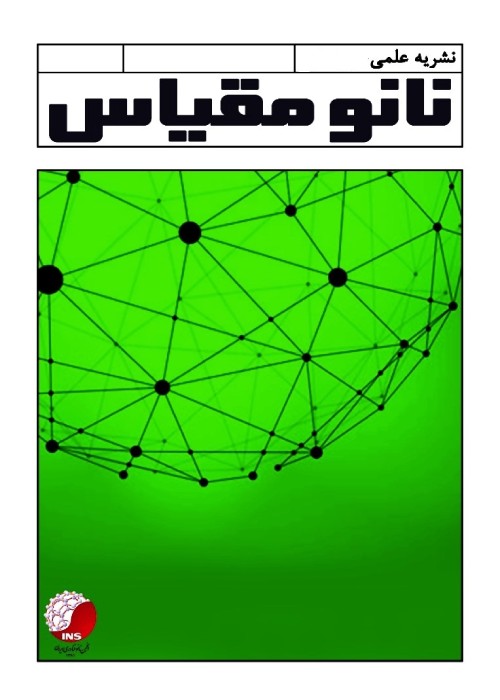فهرست مطالب

فصلنامه نانو مقیاس
سال سوم شماره 1 (پیاپی 9، بهار 1395)
- تاریخ انتشار: 1395/02/23
- تعداد عناوین: 7
-
-
صفحه 1در این پژوهش نانوذرات فریت منیزیم، مس و کادمیم با استفاده از روش عملیات گرمایی در حضور پلی ونیل الکل PVA سنتز شدند. مشخصات ساختاری نمونه ها توسط پراش پرتو ایکسXRD تعیین گردید که نتایج حضور فازهای بلوری را در تمام نانو فرایت ها تایید نمودند. با استفاده از تصاویرمیکروسکوپ الکترونی روبشی گسیل میدانی FESEMاندازه نانوذرات فریت منیزیم، مس و کادمیم به ترتیب 5 الی 8، 10 الی33 و 47 الی 138 نانومتر بدست آمد. طیف سنج مادون قرمزFT-IR وجود گروه عاملی فلز اکسید را در همه ی دما ها تایید کرد، همچنین طیف سنجFT-IR نشان داد که در دما های بالاتر از 773 درجه کلوین، مدهای مربوط به ترکیب های آلی حذف شدند. خواص مغناطیسی نانو ذرات مانند مغناطش اشباعMs و وادارندگی-مغناطیسی Hc توسط دستگاه مغناطیس سنج نمونه ارتعاشیVSM در دمای اتاق بررسی شد که نشان دادند ، نانوذرات فریت کادمیم و فریت مس رفتار فرومغناطیس و نانوذرات فریت منیزیم، رفتار سوپر پارامغناطیس داشتند. دستگاه تشدیدمغناطیسی الکترون EPR وجود الکترون های جفت نشده برای همه ی نانوفریت ها را نشان داد، همچنین با استفاده از EPR عرض قله-درهΔHpp ، میدان مغناطیسی تشدیدیHr و ضریبg اندازه گیری شد.کلیدواژگان: عملیات گرمایی، پلی ونیل الکل، فرومغناطیس، سوپرپارامغناطیس، الکترون های جفت نشده
-
صفحه 11در این مقاله، نانوذرات طلا به روش شیمیایی تهیه شده است. خواص اپتیکی این نانوذرات توسط طیف جذب مرئی- فرابنفش، روش روبش-z و طیف سنجی رامان مطالعه شده است. همچنین با استفاده از روش طیف نگاری، ضریب تضعیف جرمی گاما در انرژی های مختلف برای نانوذرات تهیه شده، محاسبه شده اند. طیف جذب مرئی- فرابنفش این مواد، پیک جذبی در محدود 530 نانومتر را نشان می دهد. ضریب شکست غیرخطی و ضریب جذب غیرخطی در شدت 40 میلی وات توسط لیزر نئودیم یگ پیوسته با طول موج nm 532 به کمک چیدمان دریچه بسته و باز روبش-z به ترتیب از مرتبه cm2/W 10-8وcm/W 10-4به دست آمده-اند. به کمک طیف سنجی رامان ارتعاشات شبکه بررسی شده است. اندازه گیری های انجام شده، نشان دهنده تاثیر پرتودهی گاما بر ضریب تضعیف جرمی گاما و خواص اپتیکی نانو ذرات طلا می باشد.کلیدواژگان: نانوذرات طلا، خواص اپتیکی، طیف سنجی رامان، روش روبش، z، ضریب تضعیف جرمی، پرتودهی گاما
-
صفحه 27در دهه های اخیر استفاده از هیدروژن به عنوان یک حامل انرژی پاک به دلیل مشکلات زیست محیطی سوخت های فسیلی بسیار مورد توجه قرار گرفته است. به منظور تولید درجای هیدروژن از متانول به عنوان روشی کاربردی جهت تامین خوراک پیل های سوختی وسایل نقلیه، در این مقاله از نانوکامپوزیت های CuO-ZnO-Al2O3 استفاده گردیده است. این نانوکامپوزیت ها به روش سریع و ساده سنتز احتراقی با مایکروویو سنتز شده اند. با توجه به اینکه نسبت سوخت به نیترات از جمله پارامترهای تاثیرگذار بر کیفیت نانوکامپوزیت تولیدی می باشد، اثر نسبت گلیسرول به نیترات در این تحقیق مورد بررسی قرار گرفته است. جهت تعیین خصوصیات فیزیکی شیمیایی نانوکامپوزیت های سنتزی از آنالیزهای XRD، FESEM، FTIR، EDX و BET استفاده شده است. نتایج این آنالیزها نشان می دهد که افزایش این نسبت موجب کاهش بلورینگی اکسید روی می گردد. همچنین تغییر این نسبت موجب ایجاد یک مقدار بهینه از لحاظ پراکندگی فاز فعال و مساحت سطح می گردد. نتایج ارزیابی راکتوری نیز اثبات کرد افزایش نسبت گلیسرول به نیترات دارای یک مقدار بهینه از لحاظ درصد تبدیل متانول می باشد که این مقدار 2 می باشد. در نتیجه نانوکامپوزیت CZAG/N2 به دلیل مساحت سطح و پراکندگی فاز فعال بیشتر دارای تبدیل متانول بالاتری است. همچنین نتایج پایداری این نمونه در مدت 1440 دقیقه نشان می دهد که تغییر محسوسی در میزان تبدیل و گزینش پذیری محصولات حاصل نمی شود.کلیدواژگان: نانوکامپوزیت CuO، ZnO، Al2O3، سنتز احتراقی مایکروویو، نسبت گلیسرول به نیترات، متانول، هیدروژن
-
صفحه 47در این مقاله به بررسی ساختار نانو ذرات هسته-پوسته مغناطیسی عامل دار شده بوسیله گروه ایمیدی با شیوه هم رسوبی پرداخته می شود. نانو ذرات مگنتیت به عنوان هسته و یک ابر پارامغناطیس فوق اشباع و غیر سمی استفاده و روی آن با یک لایه سیلیکا پوشش داده شد. این نانو ذرات هسته-پوسته به وسیله آمینو پروپیل تری اتوکسی سیلان عاملدار شد و در مرحله آخر رنگدانه های پریلن تترا کربوکسیلیک اسید دی نیدرید به نانوذرات مغناطیسی اضافه گردید. سپس تاثیر لایه های مختلف بر خواص مغناطیسی، ساختار و حرارتی نانو-ذرات هسته-پوسته مورد مطالعه وبررسی قرار گرفت. ساختار بلوری نانو ذرات توسط دستگاه پراش اشعه ایکس مطالعه گردید. برای تعیین شکل ظاهری ذرات از میکروسکوپ الکترونی روبشی استفاده گردید و به منظور بررسی خواص مغناطیسی نانوذرات هسته-پوسته از دستگاه مغناطومتر نمونه مرتعش استفاده گردید. پایداری ساختار نانوذرات هسته-پوسته از آنالیز حرارتی بررسی گردید. در نهایت و به منظور شناسایی پیوندها از طیف سنج مادون قرمز استفاده شد.کلیدواژگان: ابرپارامغناطیس، گروه ایمیدی، مگنتیت، هم رسوبی
-
صفحه 55در سال های اخیر استفاده از ضد قارچ ها برای درمان بیماری ها، صنایع کشاورزی و دامپروری افزایش پیدا کرده است. این ترکیبات به صورت آزاد و متابولیزه در سطح وسیع وارد منابع آب های سطحی، آشامیدنی و خاک می شوند. این پراکندگی ضدقارچ ها در طبیعت سبب بروز مشکلاتی از قبیل تخریب جمعیت قارچی بومی منطقه ها و ایجاد مقاومت قارچی به ضدقارچ ها می شود. در این تحقیق طراحی و ساخت نانوصفه های اکسید گرافن مغناطیسی به منظور تولید جاذب مناسب برای جذب ضدقارچ کتوکونازول، صورت گرفت و از روش استادن مایر به منظور تولید اکسید گرافن استفاده گردید. نتایج نشان داد که بیشترین راندمان جذب در متغیرهای مورد مطالعه، مقادیر 6 pH، زمان min 5 و غلظت آلاینده mg/l10 بدست آمد. فرآیند جذب از ایزوترم تمکین با99/0 R2و سینتیک درجه دوم با 986/0 R2 پیروی می کند. نتایج به دست آمده در این مطالعه، قابلیت بالای اکسید گرافن مغناطیسی جهت حذف داروی کتوکونازول از آب را نشان می دهد.کلیدواژگان: کلید واژگان: اکسید گرافن، ضدقارچ، کتوکونازول، تمکین
-
Page 1In this research, magnesium ferrite, copper ferrite and cadmium ferrite nanoparticles were synthesized by thermal treatment method by using a solution that contained polyvinyl alcohol PVA. The structural characteristics of the calcined samples were determined by X-ray diffractionXRD that the results confirmed the presence of crystal phases in the all ferrite nanoparticles. Field emission scanning electron microscopeFESEM obtained the particle sizes of the 5 to 8, 10 to 33 and 47 to 138 nm for magnesium ferrite, copper ferrite and cadmium ferrite nanoparticles respectively. Fourier transform infrared spectroscopyFT-IR confirmed the presence of metal oxide bands for the all calcined samples. Moreover, FT-IR spectra showed that the modes which related to organic compounds removed in more than 773 K. Magnetic properties such as saturation magnetizationMs and magnetic coercivityHc were obtained at room temperature by using a vibrating sample magnetometerVSM which demonstrated cadmium and copper ferrites had ferromagnetic behaviors and magnesium ferrite had superparamagnetic. Electron paramagnetic resonanceEPR spectroscopy showed the existence of unpaired electrons for the all ferrite nanoparticles and measured the peak-to-peak line width ΔHpp, the resonant magnetic fieldHr and the g-factor values.Keywords: Thermal treatment, Poly vinyl alcohol, Ferromagnetic, Superparamagnetic, Unpaired electrons
-
Page 11Au nanoparticles have been synthesis by chemical method. Optical properties of Au nanoparticles have been studied by using UV-Vis and z-scan method and Raman spectroscopy. In addition, the mass attenuation coefficients of the synthesized nanoparticles at different energies were measured by the gamma spectroscopy method. The UV-Vis spectrum of these nanoparticles exhibit an absorption peak at 530 nm region. Nonlinear reflection and nonlinear absorption indexes obtain from close aperture and open aperture z-scan in order of 10-8 cm2/W and 10-4 cm/W were studied with using continue wave Ne: YAG laser λ532 nm by use of closed aperture and open aperture z-scan setup, respectively. The performed measurements show that gamma irradiation affects the mass attenuation coefficient and optical properties of Au nanoparticles.Keywords: Au nanoparticles, Optical properties, Raman spectroscopy, z, scan method, attenuation coefficient, gamma irradiation
-
Page 27In recent decades, the utilization of hydrogen as a clean energy carrier due to environmental problems of fossil fuels is highly regarded. In order to produce on-board hydrogen from methanol as an effective method for applying feed of fuel cell vehicles, in this paper CuO-ZnO-Al2O3 nanocomposites are used. These nanocomposites were synthesized by the fast and simple microwave assisted combustion method. Considering that the fuel/nitrates ratio is one of the effective parameters on quality of the prepared nanocomposite, the effect of glycerol to nitrates ration were investigated in this study. XRD, FESEM, FTIR, EDX, and BET analyses were used to determine the physicochemical properties of fabricated nanocomposites. These analyses suggested that increasing of this ratio led to decrease of zinc oxide crystallinity. Also the change of this ratio resulted an optimum of active phase dispersion and surface area. The catalytic experiments results proved that enhancement of glycerol/nitrates ratio to methanol conversion have an optimum value which is 2. As a result, the CZAG/N2 due to higher surface area and dispersion of active phase has higher methanol conversion. Also, the stability results of this sample for 1440 minutes showed that no significant change in methanol conversion and products selectivity.Keywords: CuO, ZnO, Al2O3 Nanocomposite, Microwave Assisted Combustion, Glycerol, Nitrates Ratio, Methanol, Hydrogen
-
Page 47In this paper, the structure of the magnetic core-shell nanoparticles functionalized by an imide group was investigated by a simple co-precipitation method. The Fe3O4 nanoparticles as a super paramagnetic and Non-toxic core it was covered with a layer of silica. The resulting nanoparticle functionalized by amino trie thoxy silane and then by Perylene pigments Ttracrbonic acid anhydride. The magnetic structural and thermal properties of the new imide functionalized nanoparticles investigated. The crystaline structures of the nanoparticles were studied by X-ray diffraction and crystalline size was calculated using the Debye-Scherrer formula. The shape, morphology and The approximate size of the nanoparticles was determined by scanning electron microscopy SEM.The magnetic properties of nanoparticles was investigated by Magnetometer vibrating sample VSM that shown superparamagnetic behavior for the samples. The thermal properties of the new imide functionalized nanoparticles were investigated by thermal analysis TGA. Finally, infrared spectrometer FTIR was used to identify the nanoparticles functionality.Keywords: Superparamagnetic, Imide functionalized, Magnetite, Co, precipitation
-
Page 55In recent years the use of anti-fungal for the treatment of diseases in agriculture and animal husbandry industry has increased. This compounds are metabolized and freely broadly entered into surface water sources, drinking and soil. The distribution of anti-fungal in nature, causing problems such as destruction of indigenous fungal population And fungal resistance to the antifungal gets. In this research, design and manufacture of magnetic graphene oxide nano sheet to produce suitable absorbent to absorb the antifungal ketoconazole. And the Staden-Meier method was used to produce graphene oxide And the stand-Meier method was used to produce graphene oxide.The results of present study showed that the highest removal efficiency of studied variables are pH6, time 15 min and pollutant concentration 10 mg/ml. Absorbtion process resulted from Tempkin adsorption isotherm and quadratic kinetics is R20/99 and R20/986,respectively. The results obtained from this study showed the ability of magnetic graphene oxide to the elimination of ketoconazole drug from water.Keywords: Key word: anti, fungal, ketoconazole, graphene oxide, Tempkin


